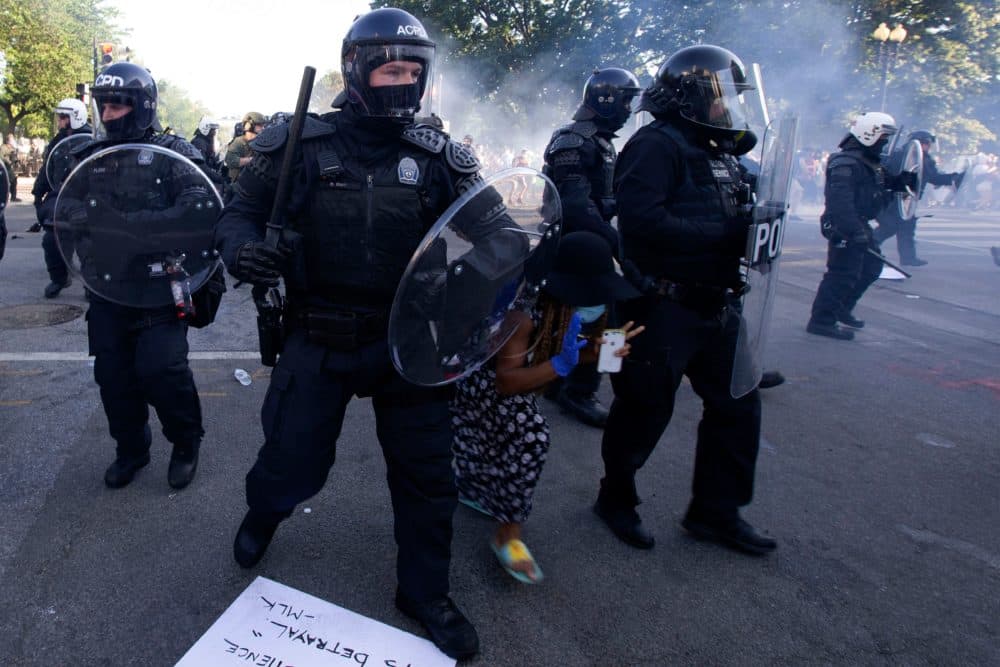Advertisement
Banned On The Battlefield: The History And Future Of Tear Gas

Tear gas can't be used by soldiers on the battlefield, so why is it used by police on American streets? We discuss the history and possible future of tear gas.
Guests
Anna Feigenbaum, associate professor in communication and digital media; deputy head of the communication and journalism department at Bournemouth University. Author of "Tear Gas: From the Battlefields of World War I to the Streets of Today." (@drfigtree)
Braxton Winston, member at-large of the Charlotte, N.C. City Council. (@BraxtonWinston)
Excerpt from "Tear Gas: From the Battlefields of World War I to the Streets of Today" by Anna Feigenbaum
Excerpt from "Tear Gas: From the Battlefields of World War I to the Streets of Today" by Anna Feigenbaum. Copyright 2017 © by Anna Feigenbaum, published by Verso Books. Reprinted with the permission of the publisher, Verso Books, an imprint of New Left Books. All rights reserved.
From The Reading List
Washington Post: "Opinion: Being teargassed never leaves you. That’s why my city is working to stop its use." — "Four years ago, while I and others were peacefully protesting the death of Keith Lamont Scott, I had my first experience with chemical weapons."
Mother Jones: "How Tear Gas Became the White Supremacist’s Favorite Poison" — "The duty of a 'true American' is the 'protection of our country against any foreign dangers whatsoever, whether it is from aliens outside, or not.' This was General Amos Fries 100 years ago, sounding very much like a Donald Trump tweet."
Jacobin: "The Paradox of Tear Gas" — "Earlier this week, thousands of people joined a general strike in Puerto Rico’s capital, mobilizing on Mayday to protest the crippling austerity that’s been imposed on the island. In response, police fired rubber bullets and released choking clouds of teargas into the crowd."
The Atlantic: "100 Years of Tear Gas" — "In August 1914, French troops fired tear-gas grenades into German trenches along the border between the two countries. While the exact details of this first tear-gas launch are fuzzy, historians mark the Battle of the Frontiers, as World War I’s first clashes between France and Germany came to be known, as the birthday of what would become modern tear gas."
New York Times: "Here Are the 98 U.S. Cities Where Protesters Were Tear-Gassed" — "At least 98 law enforcement agencies — many in large cities — used some form of tear gas against civilians protesting police brutality and racism in recent weeks, according to an analysis by The New York Times."
Associated Press: "Seattle mayor bans 1 type of tear gas amid protests" — "The Seattle mayor has banned the police use of one form of tear gas as protests continue in the city and nationally over the killing of George Floyd."
WFAE: "Winston Wants To Cut Funding For Tear Gas In City Budget" — "Charlotte City Council member Braxton Winston wants the city to eliminate money in next year's police department budget for chemical agents such as tear gas that are used to disperse crowds."
Vox: "The disturbing history of how tear gas became the weapon of choice against protesters" — "It was a chilling split screen at the start of June: President Donald Trump preparing to give an address in the White House Rose Garden as dozens and dozens of protesters right outside were being pushed back on the streets by federal law enforcement firing what appeared to be tear gas."
Insider: "'Rahul is a f---ing champ': The DC man who gave refuge to more than 70 protesters fleeing police and pepper spray is being heralded as a legend" — "Rahul Dubey was standing outside his Washington, DC, home on Monday night when police corralled hundreds of peaceful protesters onto Swann Street."
Al Jazeera: "Opinion: The US protests and the echoes of imperial violence" — "As the world was gripped by the shocking scenes of police brutality against the Black community in the United States and the aggressive posture adopted by President Donald Trump against the protestors, an important development was missed by many observers."
San Francisco Chronicle: "Opinion: A medical call to ban tear gas: It can be especially lethal in a pandemic" — "As a physician and an American, I am outraged by ongoing police violence, enabled by local and national leaders."
New York Times: "Corrosive Effects of Tear Gas Could Intensify Coronavirus Pandemic" — "The billowing clouds of tear gas that the authorities are sending through protest crowds across the United States may increase the risk that the coronavirus could spread through the gatherings."
WAMU: "'We Were All Terrified': Protesters Describe Chaos On Swann Street" — "Samanta Troper was on her way to get coffee in Dupont Circle on June 1 when she saw a group of people rallying to protest the killing of Tony McDade, a black transgender man fatally shot by a police officer in Florida in May."
This program aired on June 18, 2020.
